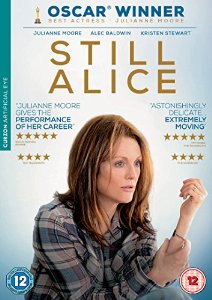Still Alice.
Still
Alice. Film Review.
"The
art of losing isn't hard to master. So many things seem filled with the intent
that their loss is no disaster."
If
we are defined by our intelligence, our language and articulation, then just
imagine what it would be like to lose them all.
Julianne Moore, a versatile performer, dubbed the Queen of realism, won
an Academy Award in 2015 for her portrayal of Alice Howland, the 50 year old
linguistics' Professor from Columbia University, diagnosed with early onset
Alzheimer's, a rare familial type that meant her children stood a 50/50 chance
of inheriting the gene.
Recently
we have seen a surge in films showing cancer victims as well as Alzheimer
victims. Take for instance "The
Fault in Our Stars" or "50/50"
even "The Notebook" and "Away From Her." Then, of
course there's John Bayley's sad account of how Alzheimer's claimed his wife,
the famous writer Iris Murdoch in the film "Iris."
Bayley gave a brutally frank description of what it was like being married to
someone with this disease. It is "like
being chained to a corpse." Superficially these films are seen as
being similar.
But
"Still Alice" differs in
that the main character is depicted as a fully-formed person right from the
start and well-educated, before the disease brutally destroys her intellect,
her memories and her ability to use language for communication. As the sufferer,
it is Alice who is at the centre of it, helplessly watched by her family. The
film begins deceptively with a 50th birthday celebration for Alice with
everyone oblivious to the tragedy that will unfold before their eyes. It seems
to be a happy occasion, a united family celebrating a birthday. Husband John, a
physician (Alec Baldwin: Mission
Impossible Rogue Nation, Blue Jasmine, Rock of Ages fame). Son Tom (Hunter
Parrish), daughter Anna (Kate Bosworth) and husband, Charlie (Shane McRae). The
only absence is Alice's youngest daughter, Lydia (Kristen Stewart The Twilight Saga).
The
film is based on Lisa Genova's debut novel. It was meant to be a small Indie
film, a "little" independent project on a small budget of 4 million
dollars and it took three and a half weeks to make. Alzheimer's has become the
most feared disease of the 21st century so it’s not surprising that this film
took centre stage and attracted lots of interest. Its world premiere at the
Toronto International Film Festival received critical acclaim, particularly from
Moore’s performance, her “sheer precision
and delicacy.” (Collin/The Telegraph.) Alzheimer’s is the most common form of
dementia which causes memory loss, difficulty with thinking and language. It
usually affects the over 65s, although people as young as 50 can develop the
symptoms. For Alice, being diagnosed at 50 means it is seen as early onset
Alzheimer's.
“We
become ridiculous, incapable, comic, dependent, struggling to communicate or
understand.”
There is a sudden regression into helplessness. Behaviour turns strange,
sentences become fumbled and people’s perceptions of sufferers will change.
Memory
lapses whilst giving a lecture make Alice anxious. She loses her grip
temporarily, trying to search for the word “lexicon,” a word familiar to her. Following on,
she goes out jogging around the campus and becomes lost and confused. She stops
and we see panic in her face. The camera rotates around her, encircling her.
She is breathless, then loses focus and the image becomes blurred. She then
stoops, takes a few deep breaths. We then see her at home, feeling despondent
and exhausted. At Christmas she welcomes her son Tom’s girlfriend Christine
twice. Nothing serious but these incidents do represent tell-tale signs that
something isn’t quite right. She tells John: “It feels like my brain is f…ing dying. And everything in my life I
have worked for is going.”
Alice
believes she has a brain tumour and visits a neurologist, Travis Benjamin who
suggests doing an MRI followed by a PET scan. The scans show evidence of
sporadic memory impairment caused by early onset Alzheimer’s. Alice is
naturally devastated, wishing that she had cancer instead reminding us that
people wear pink ribbons and raise money to show solidarity. What do they do
for Alzheimer’s? “There’s a tremendous
amount of shame around the disease and people feel like they’re not seen, they
feel isolated.” (Julianne Moore.)
To
take some control over her mind whilst she can, she types a number of questions
and answers into her phone such as her eldest daughter’s name and the month of
her birthday. She consults this every day and keeps lists in her kitchen to
memorize. Sadly, she records a message on her laptop, filed under Butterfly for when her condition becomes
so severe and she instructs herself to take an overdose and end it. From time
to time we see images of her late sister and mother who were killed in a car
crash in 1972 when Alice was 18 years of age. They always seem happy, walking
or playing on the beach.
The
film shows us Alice’s decline from forgetfulness to total destruction of her
memory and intelligence. This absence and vacancy is what she referred to as
hell and worse than that at the conference where she was invited to talk about
her illness. The film successfully shows her pitiful decline without plunging
us into flat despair. It is an emotional journey for us too but not as
pitilessly harrowing as Michael Hanebe’s “Amour.”
You’ll enjoy the intensity of this journey and hopefully learn to appreciate
the simple things in life.
“Because nothing is
lost for ever. In this world there is a kind of painful progress. A longing for
what we’ve left behind. And dreaming about.”
Alice is still Alice in spite of this cruel illness. Her legacy lives on in her
family. Believability.
REVIEW
it by Carol Naylor.
Copyright 2016. Permission must be obtained from the author before any of this article review is reproduced.




Comments
Post a Comment